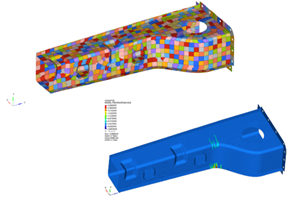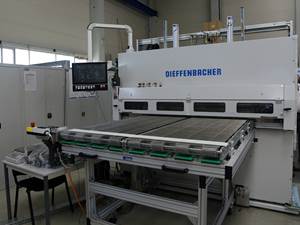Detroit Auto Show
2007 NAIAS exhibition spotlights new composites applications.
The 2007 North American International Auto Show, held Jan. 13-21 at the Cobo Conference/Exhibition Center in Detroit, Mich., once again served as the leading showcase for production and concept vehicle introductions from domestic and international OEMs. A number of hybrid vehicles were featured, reflecting the industry's increasing awareness of environmental concerns, such as global warming. Among them was General Motors' Volt concept car, with batteries and electric motors capable of running up to 40 miles (64 km) on a single six-hour charge before its small gasoline engine kicks in to generate sufficient electricity to power the motors until the car's batteries can be recharged. Because many people drive less than this distance most days, it is possible that a tank of fuel could last a very long time, provided the car's owner remembers to plug the vehicle in at night. Notable for the number of plastic and composite components used on the concept, the Volt may or may not see production (if yes, possibly by 2010) and could differ significantly in terms of material use (see “Related Content,” at left).
Concurrent with the event, the Automotive Composites Alliance (ACA) held a daylong reception at a venue adjacent to Cobo Hall, featuring composite components and the chance to learn more about the materials and methods used to produce them. SMC is still the predominant composite material used on production automobiles, and a number of material and process advances have been made in materials and processing, which are covered in more detail in the feature article on p. 30. One new SMC application highlighted by the ACA was the hood for the 2008 model Dodge Viper. Although previously made of SMC, the hood was restyled during a mid-cycle upgrade of the vehicle to accommodate an 8.4L V-10 engine with larger cylinder bores, a modification that enables production of more than 600 hp. Molded by Meridian Automotive Systems (Allen Park, Mich.), the hood now includes an integrally molded front scoop and larger louvers. The outer skin is standard low-profile, Class A SMC, and the bonded inner panel is a low-density (1.3 g/cm3) structural SMC. Other recent SMC introductions include a hood for the Lincoln Navigator, molded by Continental Structural Plastics (formerly Budd Plastics, Troy, Mich.), and vinyl ester valve covers for the 13L diesel engines in Mack Truck and Cummins heavy trucks.
An interesting new hybrid composite introduction was the "Divide-N-Hide"trunk divider, available on some Nissan Sentra models. This flip-down panel, also molded by Meridian Automotive Systems, is installed about 12 inches/300 mm behind the back seat, creating a compartment that can be used to stow seldom-used or valuable items. Meridian director of engineering Tyler Hardy says the divider comprises two bonded panels. The forward panel (visible when the back seat is folded down) and latch housing must meet dynamic impact loads caused by sudden stops or accelerations, and are molded from structural 30 percent glass SMC with molded-in color. The assembly's trunk side panel is a polypropylene/flax fiber composite with molded-on carpet.
Directed fiber preforming is increasing in structural applications says Keith Bihary, automotive sales manager for Molded Fiber Glass Cos. (MFG, Ashtabula, Ohio) and the 2007 ACA chairman. Termed "positive glass placement"by MFG, the process yields components with less mechanical property variance than SMC, thanks mainly to robotic placement of the fibers prior to resin addition and compression molding. The Saturn Sky, Dodge Viper, Pontiac Solstice and Chevrolet Corvette all use structural components molded via the process. On the Corvette Z06, the floor panels and wheelhouses are made using the process and incorporate carbon fiber for 40 percent weight savings. Bihary says that, despite the current shortage of aerospace grade carbon fiber, interest in carbon is growing, in part because MFG engineers have developed techniques to use more readily available commercial-grade (large tow) carbon fiber.
Related Content
CAMX 2022 exhibit preview: Cimbar Performance Minerals
Cimbar’s halogen-free ATH solution for thermoset applications reduces resin costs in formulation, provides better wetout and faster line speeds and improves mold flow.
Read MoreDucati introduces lightweight motorcycle seat support rear frame
Forged molding compound (FMC) material from Mitsubishi Chemical and Gemini Composites replaces aluminum part on Ducati Hypermotard 939, reduces part weight by 40%.
Read MoreSMC simulation tool enhances design optimization
CAMX 2023: FiRMA, Engenuity’s new approach to SMC, uses a predictive technique that accurately reflects material properties and determine the performance range an SMC part or structure will exhibit.
Read MoreDieffenbacher highlights Fibercut system for increased productivity
Dieffenbacher’s fully automated cutting and stacking system enables automated SMC processing applications.
Read MoreRead Next
Composites end markets: Energy (2024)
Composites are used widely in oil/gas, wind and other renewable energy applications. Despite market challenges, growth potential and innovation for composites continue.
Read MoreFrom the CW Archives: The tale of the thermoplastic cryotank
In 2006, guest columnist Bob Hartunian related the story of his efforts two decades prior, while at McDonnell Douglas, to develop a thermoplastic composite crytank for hydrogen storage. He learned a lot of lessons.
Read MoreCW’s 2024 Top Shops survey offers new approach to benchmarking
Respondents that complete the survey by April 30, 2024, have the chance to be recognized as an honoree.
Read More






















